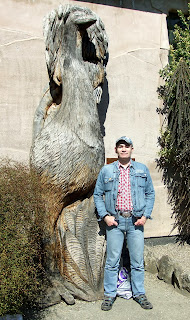Photographed in 2006 alongside the sturdy,
relatively short-legged Aotea Moa Statue, designed and sculpted (in concrete?) by
Robin Coleman of Marton, and standing outside the Aotea New Zealand Souvenir
Store on Queen Street in the centre of Auckland, on North Island, New Zealand –
might it have been inspired by a Pachyornis species? (© Dr Karl Shuker)
It is well established that the extinct moas constituted a group
of ratites exclusive to New Zealand - which is why
the little-known tale of Australia's unique Queensland moa is worth
retelling. So here it is.
In 1884, this zoogeographical heretic was christened Dinornis
queenslandiae by English-born zoologist Charles W. De Vis (at that time the
director of the Queensland Museum), in a Proceedings
of the Royal Society of Queensland paper. He based
its species on a fossilised, incomplete left femur, spotted by him in a
collection of bones from King's Creek, on Queensland's Darling Downs,
that had been presented to the museum by a Mr J. Daniels of Pilton. Naturally,
the specimen attracted great interest among ornithologists, as it extended the
moas' distribution very considerably. No longer were they a novelty of New Zealand - always
assuming, of course, that it really was a moa.
The contentious partial left femur upon which the Queensland
moa was established (Figs 1 and 2 from De Vis's Proceedings of the Royal
Society of Queensland paper, 1884 – public domain)
Over the years, however, this assumption became a much-debated
issue.
In 1893, for instance, eminent New Zealand naturalist Captain
Frederick W. Hutton deemed the bone to be from a cassowary-like species that
probably represented the common ancestor of emus and cassowaries, which are
currently classed together within the same taxonomic order, Casuariiformes (and
click here
to access my ShukerNature article documenting some very controversial
cassowaries). He documented his opinion in a Proceedings of the Linnean
Society of NSW paper.
Australian emu Dromaius novaehollandiae (top)
and double-wattled aka southern cassowary Casuarius casuarius (bottom)
(public domain)
Then in 1949 its species was readmitted to the moa brotherhood,
when Dr Walter R.B. Oliver of Wellington's Dominion Museum renamed it Pachyornis
queenslandiae in a Bulletin: Dominion Museum (New Zealand) paper. By the
early 1960s, conversely, it was back among the emus and cassowaries, when in
1963, within a Records of the South Australian Museum paper, American
ornithologist Dr Alden H. Miller (director
of the Museum of Vertebrate Zoology at the University of California, Berkeley,
for 25 years) classified it as an emu, dubbing it Dromiceius [=Dromaius]
queenslandiae. It seemed as if this contentious species would be
spending the rest of time ricocheting from one ratite family to another - but
then came the study that finally brought its taxonomic tribulations to a
long-awaited end.
This was when, in April 1967, osteologist Ronald J. Scarlett
from New Zealand's Canterbury Museum examined the Queensland moa's femur and
revealed that it was indeed from a Pachyornis moa, but specifically the
heavy-footed moa P. elephantopus (the presence and precise shape of a bony
femoral projection called the cnemial crest clinched this taxonomic
identification). He also paid close attention to the other bones in the
original King's Creek collection within which it had been found by De Vis back
in the 1880s.
Skeleton of the heavy-footed moa Pachyornis
elephantopus skeleton in the Naturhistorisches Museum of Basel, Switzerland
(public domain)
In so doing, Scarlett recognised that the femur was strikingly
different in general appearance and colour from the rest of this collection's
material, and clearly had not been obtained with it. In addition, his very
appreciable experience with moa bones derived from caves, Maori middens,
swamps, and other sources of such remains enabled him to reveal something even
more significant – the femur was readily identifiable as a bone originating
from a midden in New Zealand's South Island. Consequently,
it was not from Australia at all! In
1969, Scarlett documented his revelatory findings in a Memoirs of the
Queensland Museum paper.
In short, the (in)famous Queensland moa was just another
non-existent creature that had been granted a transient reality by the
evocation of inaccurate information and incomplete investigation - a mere
monster of misidentification, nothing more. Pachyornis queenslandiae -
R.I.P.!
Reconstruction
of the heavy-footed moa in life (© niaolei.org.cn – reproduced here
on a strictly educational, non-commercial Fair Use basis only for the purposes
of review)
My sincere thanks go to the late Ron Scarlett for so
kindly communicating with me regarding this once-controversial form (and other
moa mysteries) during the 1990s, and for bringing his study and published paper
concerning it to my attention.
This ShukerNature article is excerpted and expanded
from my book The Beasts That Hide From Man.
Alongside a life-sized statue carved
in 2004 by Frank Triggs of the giant moa Dinornis at Chester Zoo,
England, in 2013 (© Dr Karl Shuker)

























